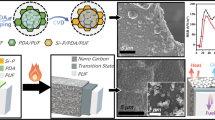Abstract
Mechanical properties of metallic foams are highly dependent on the characteristics of porosity. In the case of foams manufactured using space holder particles (SHPs), parameters such as percentage porosity, pore size and cell wall thickness are directly contingent on the SHP used. In this work, different fractal distributions of SHPs were introduced in order to modify the resulting porosity. An Al–Si–Cu alloy was used as raw material for producing metallic foams by infiltration, while NaCl particles of 2 and 4 mm were used as SHPs, modifying the small-to-large particle ratio and fractal dimensions. Cylindrical foams of 10 cm in height and 5 cm in diameter were obtained by infiltrating the Al alloy into the SHPs. Results showed that the use of fractal distribution allowed to slightly increase the percentage porosity, whereas the most important effect was the decrease in cell wall thickness when fractal dimension increased. Mechanical properties were directly affected by these modifications, decreasing when fractality was induced. Finite element analysis models of the foams were obtained in a combination with discrete element method, in order to simulate their compressive elastic behaviors. Young’s modulus estimations were in excellent agreement with experimental results, validating the effect of fractal inclusion and the importance of the correct model selection.







Similar content being viewed by others
References
Banhart J (2007) Metal foams-from fundamental research to applications. In: Baldev R, Ranganathan S, Rao KB, Matthew MD, Shankar P (eds) Frontiers in the design of materials. Universities Press Limited, Hyderabad, pp 279–289
García-Moreno F (2016) Commercial applications of metal foams: their properties and production. Materials 9:85. https://doi.org/10.3390/ma9020085
Papadopoulos DP, Konstantinidis ICh, Papanastasiou N, Skolianos S, Lefakis H, Tsipas DN (2004) Mechanical properties of Al metal foams. Mater Lett 58(21):2574–2578. https://doi.org/10.1016/j.matlet.2004.03.004
Banhart J (2001) Manufacture, characterisation and application of cellular metals and metal foams. Prog Mater Sci 46:559. https://doi.org/10.1016/S0079-6425(00)00002-5
Jha N, Mondal DP, Dutta Majumdar J, Badkul A, Jha AK, Khare AK (2013) Highly porous open cell Ti-foam using NaCl as temporary space holder through powder metallurgy route. Mater Des 47:810–819. https://doi.org/10.1016/j.matdes.2013.01.005
Pérez L, Lascano S, Aguilar C, Domancic D, Alfonso I (2015) Simplified fractal FEA model for the estimation of the Young’s modulus of Ti foams obtained by powder metallurgy. Mater Des 83:276–283. https://doi.org/10.1016/j.matdes.2015.06.038
Altinkök N (2019) Modeling of the mechanical and physical properties of hybrid composites produced by gas pressure infiltration. J Braz Soc Mech Sci Eng 41:13. https://doi.org/10.1007/s40430-018-1518-5
Mat Noor F, Zain MIM, Jamaludin KR, Hussin R, Kamdi Z, Ismail A, Ahmad S, Taib H (2014) Potassium bromide as space holder for titanium foam preparation. Appl Mech Mater 465–466:922–926. https://doi.org/10.4028/www.scientific.net/AMM.465-466.922
Aristoff D, Radin C (2009) Random loose packing in granular matter. J Stat Phys 135:1–23. https://doi.org/10.1007/s10955-009-9722-4
Chang CS, Wang JY, Ge L (2015) Modeling of minimum void ratio for sand-silt mixtures. Eng Geol 196:293–304. https://doi.org/10.1016/j.enggeo.2015.07.015
Groot R, Stoyanov S (2011) Close packing density and fracture strength of adsorbed polydisperse particle layers. Soft Matter 7:4750–4761. https://doi.org/10.1039/C0SM00859A
Mandelbrot BB, Passoja DE, Paullay AJ (1984) Fractal character of fracture surface of metals. Nature 308:721–722. https://doi.org/10.1038/308721a0
Muñoz S, Castillo SM, Torres Y (2018) Different models for simulation of mechanical behaviour of porous materials. J Mech Behav Biomed 80:88–96. https://doi.org/10.1016/j.jmbbm.2018.01.026
Pérez L, Lascano S, Aguilar C, Estay D, Messner U, Figueroa IA, Alfonso I (2015) DEM–FEA estimation of pores arrangement effect on the compressive Young’s modulus for Mg foams. Comput Mater Sci 110:281–286. https://doi.org/10.1016/j.commatsci.2015.08.042
Chawla N, Sidhu RS, Ganesh VV (2006) Three-dimensional visualization and microstructure-based modeling of deformation in particle-reinforced composites. Acta Mater 5:1541–1548. https://doi.org/10.1016/j.actamat.2005.11.027
Cundall PA, Strack OD (1979) A discrete numerical model for granular assemblies. Geotechnique 29:47–65. https://doi.org/10.1680/geot.1979.29.1.47
Kloss C, Goniva C, Hager A, Amberger S, Pirker S (2012) Models, algorithms and validation for opensource DEM and CFD-DEM. Prog Comput Fluid Dyn 12:140–152. https://doi.org/10.1504/PCFD.2012.047457
Hasan A (2010) An improved model for FE modeling and simulation of closed cell Al-alloy foams. Adv Mater Sci Eng 2010:1–12. https://doi.org/10.1155/2010/567390
Florek R, Simančík F, Nosko M, Harnúšková J (2010) Compression test evaluation method for aluminium foam parts of different alloys and densities. Powder Metall Prog 10:207–212
Zhu HX, Knott JF, Mills NJ (1997) Analysis of the elastic properties of open-cell foams with tetrakaidecahedral cells. J Mech Phys Solids 45:319–343. https://doi.org/10.1016/S0022-5096(96)00090-7
Warren WE, Kraynik AM (1988) The linear elastic properties of open-cell foams. J Appl Mech 55:341–346. https://doi.org/10.1115/1.3173680
Gan YX, Chen C, Shen YP (2005) Three-dimensional modeling of the mechanical property of linearly elastic open cell foams. Int J Solids Struct 42:6628–6642. https://doi.org/10.1016/j.ijsolstr.2005.03.002
Acknowledgements
I. Alfonso would like to acknowledge the financial support from SEP CONACYT 285215 and UNAM PAPIIT IN117316. R. Drew acknowledges the financial support from PREI DGAPA UNAM. L. Pérez acknowledges the financial support from the Advanced Center for Electrical and Electronic Engineering, AC3E, Basal Project FB0008, CONICYT. R. Ganesan acknowledges the financial support from the Chilean Agency CONICYT (FONDECYT Project 3150411).
Author information
Authors and Affiliations
Corresponding author
Additional information
Technical Editor: João Marciano Laredo dos Reis.
Publisher's Note
Springer Nature remains neutral with regard to jurisdictional claims in published maps and institutional affiliations.
Rights and permissions
About this article
Cite this article
Carranza, J.C., Pérez, L., Ganesan, R. et al. Effect of fractal distribution of the porosity on mechanical properties of Al foams manufactured by infiltration. J Braz. Soc. Mech. Sci. Eng. 41, 379 (2019). https://doi.org/10.1007/s40430-019-1876-7
Received:
Accepted:
Published:
DOI: https://doi.org/10.1007/s40430-019-1876-7




